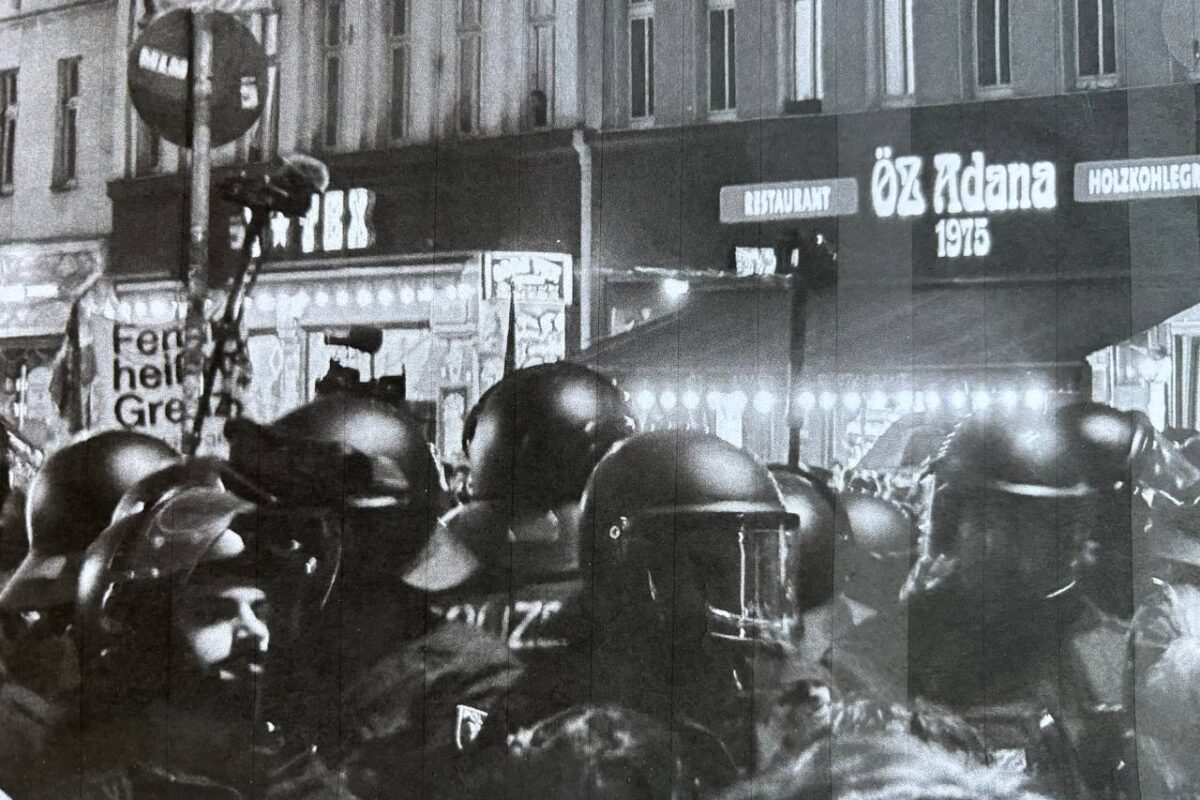We are located in Dresden, capital of Saxony, in what used to be the German Democratic Republic (GDR). Leaving from the north of the city, already where the houses end, we pass under a highway and to the left is the Heidefriedhof, one of the cemeteries that the municipality has.We enter and find a typical German cemetery, with a wide central walk and a dense wooded area on the sides scattered with tombstones.
After walking a few tens of meters along the central promenade, an obelisk with the initials of the Fédération Internationale des Résistants (FIR) is erected. It forms a cauldron from which flames rise. Below, a plate with a text in quite visible letters: “Zum Höchsten der Menschheit emporgestrebt” (Having aspired to the highest of Humanity). From this memorial, turning to the right, a monumental complex with a circular plaza and two promenades begins, which honors the struggle against fascism and reminds us of the horrors of war, an ode to peace and anti-militarism.
The collective tombs of anti-fascist fighters are located in one wing of the complex, the one closest to the FIR’s obelisk. Names are mixed in different languages, most of them are German. But we also find others such as Ángel Álvarez, Santiago Zamuz, Policarpo García-Suárez, Domingo Villanueva or Julio Aristizábal. What are these recorded names doing there? We follow the traces of Operation Bolero-Paprika.
On September 7, 1950, the French Republican Security Companies (CRS), a special police force, entered the homes of dozens of Spanish and Eastern European communists living in France. Thus began Operation Bolero-Paprika. Accused of disturbing public order or of being fifth columnists of the French Republic, they were expelled from the country. A pact between the United States, France and Franco’s Spain in the middle of the Cold War – sent many Republicans who had fought against fascism in Spain and France, against Franco and against Hitler, into a second exile.
A group of about 30 people arrived on September 10 at the border of the German Democratic Republic (GDR), where they began a new life that started in Schleiz and Malchow. Most would go to Dresden and Berlin. In the capital of Saxony, in March 1951, they left their autobiographies collected for the local authorities. This is now compiled in a book entitled “Y el año que viene – ¡En España!” edited by Margarita Banqué. Born in 1949 in France, she was the daughter of Bautista Banqué, one of the first 30 to be expelled. In this book, Ángel Álvarez relates that he was a candidate for deputy for Asturias of the Spanish Communist Party (PCE) in 1933 and then in 1936. He also says that in the GDR he was granted a 70% disability and that the doctors attended to his vertebrae and heart problems. Policarpo García, a furrier born in Madrid and later a partisan in the internal Resistance in France, was given a job by the GDR in the Sanar Eisenwerk ironworks in Cossebaude (Dresden).
One after the other, they tell us extensively about their lives. Their membership in unions and parties, their professions, the war in Spain and the fronts on which they fought, the positions and tasks they carried out for their organizations both in Spain and in exile. It follows their imprisonment in concentration camps in France, their struggle against Hitler in the French internal Resistance, and finally, their detention and deportation to the GDR. These are lives full of comings and goings, of double exile. They finally find a home for the family, a job for men and women, health care and education “on the other side of the wall”. Their experiences were forgotten for decades in an official historiography that silenced those who were communists and obscured everything that was happening “in the East”.
We are going from Dresden to Berlin, to the district of Treptow-Köpenick, southeast of the German capital. There, between the 96a highway, the S-Bahn tracks, the Spree river and the Britz Canal, is the Baumschulenweg cemetery. It has a double structure, split in two by the Kiefholzstrasse. On one side is the crematorium and several sets of graves, the old part, whose planning dates from 1911 contains black pages of history marking the incineration of 2,300 prisoners of the Sachsenhausen Concentration Camp in Oranienburg, north of Berlin. On the other side is the new part, planned and built between 1936 and 1939. In 1981 a granite and bronze monument by Gerd Thieme was erected there to honor the fighters against fascism and for socialism. At his feet, several rows of tombs contain the mortal remains of these people.
We find here Carmen Carrasco (born Carmen Ansorena), Antonio Carrasco, Francisco Rodríguez, Adela Lafuente (born Adela Fernández) and Manuel Lafuente. The latter, born in 1936, was deported with his sons Manuel and Fernando to the GDR. Fernando Lafuente still lives in Berlin today. Together with Margarita Bremer (born Margarita Banqué), editor of the book “Y el año que viene – ¡En España!”, they told recently their story for the German radio SWR. In his autobiography, Francisco Rodriguez tells us how he decided to get married for the second time in France after “long and deep meditation”. The autobiographies are not only an account of professional, trade union and political merits, they also tell us personal anecdotes like this one, sometimes even with a sense of humor. They remind us that they are not mere names, but flesh and blood people with their personal stories.
Among the Baumschulenweg tombs there is no longer the tomb of one of the most famous people expelled during Operation Bolero-Paprika: Elisa Uriz Pi (1893-1979). Pedagogue and revolutionary teacher, feminist fighter and international defender of children’s rights, Elisa received the expulsion order months after the first deportations and arrived in the GDR with a safe conduct. After a consultation with Sabine Gansauge, responsible for memorials at the cemetery, Elisa Uriz’s grave, No. 502, was removed in 2002. Three tombs away, at no. 499, however, remains the tomb of the renowned modernist architect Manuel Sánchez Arcas, along with those of María Krùs-Lobes (María Cruz López) and Celestino Uriarte, who was a leader of the PCE and the PCOE. These last ones arrived years later to the DDR, past the Bolero-Paprika.
Why is Elisa Uriz Pi not buried with the rest of the anti-fascist fighters in the operation? The most probable cause is because her death took place in 1970, before the memorial was erected in 1981. The dates of death of the rest of the Spaniards there were all later, except for Manuel Lafuente, who also died in 1970. In his case we can assume that the remains were moved to this place in 1983, when his wife Adela Lafuente died.
We turn around, leave the Baumschulenweg cemetery behind and change to Lichtenberg district. Near the station of the same name, to the left of Frankfurter Allee and walking east, is the Zentralfriedhof Friedrichsfelde. This cemetery is famous for housing the remains of Rosa Luxemburg, Karl Liebknecht, Franz Mehring or Ernst Thälmann, among others, in the Memorial of the Socialists.
Going deeper into the cemetery, among trees and tombstones, a brick stele with an inverted red triangle stands out. It marks the beginning of the rows of tombs containing the victims and people persecuted by the Nazi regime (inside or outside Germany), as well as those who fought in the Resistance. There we find a tombstone surrounded by carefully maintained vegetation that bears the names of Bautista Banqué and Teresa Banqué (born Teresa Doz). Their names are perfectly legible despite the passage of time thanks to the maintenance and cleaning work carried out mainly by the association VVN-BdA (Union of Persecuted People of Nazism – Federation of Antifascists, in its German acronym). Bautista and Teresa are the parents of the editor of the autobiographies – Margarita – who still lives in Berlin with the surname Bremer. They are the only victims of Operation Bolero-Paprika to be found here, although not the only people exiled. A few more rows in the background we find under a tree the tombstone of Josep Renau and Manuela Ballester, famous muralists, poster artists and communist painters, among other dedications. Also here were the remains of Josefa (Pepita) Úriz Pi, sister of Elisa Úriz Pi and outstanding pedagogue and leader of FETE-UGT, but her grave met the same fate as Elisa’s on Baumschulenweg.
All this history, as Margarita writes on the cover of her autobiography book, are “tesserae” of the historical memory. Their life is that little stone that goes unnoticed one by one, but which is in itself fundamental. Since each one composes the mosaic of the memory of those who fought fascism, whom history paid with such an unjust double exile for their communist membership. They are tesserae that, as archaeologists and narrators of memory, we unearth with care to bring them to light. We put them together one by one until we have the picture of a past that is only lost the moment we stop mentioning it and that deserves to be remembered. Only by knowing our history can we build the Third Spanish Republic, the one that many of the exiled communists in the GDR probably dreamed of seeing before they died.
This article first appeared in Spanish on the eldiaro Website. Reproduced with the author’s permission


